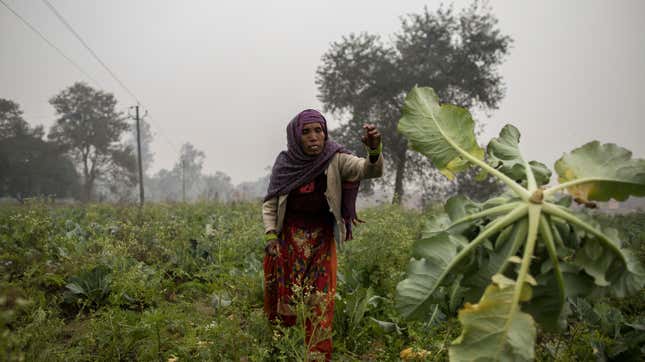
In India, agriculture employs more than 50% of the country. It’s also in crisis due to climate change and groundwater loss. A new study shows how these two factors are putting the country’s farmers at risk.
The study, published in Science Advances on Wednesday, specifically examined India’s winter harvests. In the fall and spring monsoon seasons, farmers tend to rely on rains to keep their crops hydrated, but in the winter, agriculture is primarily dependent on groundwater. But the amount of Indian land where this kind of aquifer-dependent irrigation is viable is decreasing, and the new study suggests it’s going to get worse.
The authors’ research is based on a novel satellite data modeling method to map and measure areas where winter crops are grown across the country, and compare those satellite images with data on groundwater depletion. In addition to drawing on NASA MODIS satellite data from 2000 to 2016, it also uses irrigation data at the village-level and groundwater depletion data kept by the Indian government.
“By overlaying these three sources of data, we were able to quantify the proportion of winter crop that is irrigated by depleting groundwater,” Meha Jain, an assistant professor at the University of Michigan School for Environment and Sustainability and lead author of the study, said.
Jain and her co-authors found that some 13% of the villages where farmers currently plant winter crops are in regions where groundwater is severely depleted, which mostly fall in the northwestern and central parts of the country. If all groundwater in those critically depleted regions dries up, the authors found up to 68% of their cropped area could become untenable for farming. That would represent a loss of 20% of the country’s total winter farmland.
That 20% loss is “an upperbound value that represents the most extreme, dire scenario,” Jain noted, meaning it’s “not necessarily what is most likely to happen.” Losses on that level will only occur if farmers cannot draw out water from deep alluvial aquifers where water is hidden deep in the soil rather than the shallow bedrock, coastal aquifers, or from shallow hard rock aquifers that store water after rainfall.
But none of those other aquifers are safe bets. Pulling water from deep alluvial aquifers is expensive—it requires drilling into the ground and pumping water out. Coastal aquifers may not be a good option because the water in them has become rising seas have made water stored there more salty, and that’s not great for growing crops. Decreasing rainfall means shallow hard rock aquifers are increasingly dry. So all things considered, India’s crops are in a pretty dire situation. That’s particularly bad news because Indian agriculture produces 10% of global crops, and is the second largest producer of wheat and rice, the study says.
In the non-winter growing season, heat waves and irregular monsoon patterns have made it more difficult for farmers to grow crops. Water demand in parts of the country is outstripping supply, turning up pressure even further. (This isn’t just a problem in India, but a global one.)
There are steps India could take to improve the viability of winter agriculture before reaching a crisis point, though. Jain said the government could increase farmers’ access to water from canals for irrigation. It could also boost subsidies for less water-intensive crops, such as millet, instead of subsidizing water-intensive crops like wheat and rice.
The study comes amid months of farmer-led protests throughout India at new laws passed by the Modi government. The protests have shed light on how existing farm policies make it more difficult for farmers to earn a living. By making agriculture viable and in line with water availability and the warming climate, moves like the ones Jain suggested could not only protect an important food source, but also protect jobs for hundreds of millions of Indian people.